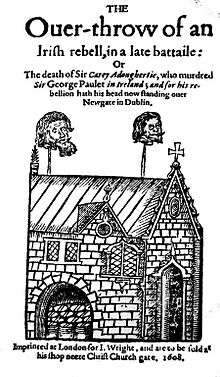Cahir O'Doherty

Sir Cahir O'Doherty (Irish: Cathaoir Ó Dochartaigh; 1587–1608) was the last Gaelic Lord of Inishowen in north-west Ireland. O'Doherty was a noted loyalist during Tyrone's Rebellion and became known as the Queen's O'Doherty for his service on the Crown's side during the fighting.[1] After the war O'Doherty had ambitions to become a courtier and applied for a position in the household of Henry Frederick, Prince of Wales, but he increasingly came into dispute with Irish-based officials such as the Viceroy Sir Arthur Chichester and the Governor of Derry Sir George Paulet. In 1608 he launched O'Doherty's Rebellion, seizing Derry from Paulet and burning it to the ground. O'Doherty was subsequently killed in a battle at Kilmacrennan, and the rebellion swiftly collapsed.
Early life
Cahir was the son of Sir John O'Doherty, the head of the O'Doherty's and effective ruler of Inishowen. Cahir's younger sister was Rosa O'Doherty who first married Cathbarr O'Donnell and later Owen Roe O'Neill.
He was fourteen when his father died and had to spend the next few years gaining control of his lordship. Cahir's foster father was Phelim Reagh MacDavitt (Mac Daibhéid). Cahir was knighted by Lord Mountjoy, and for a time seemed prepared to work amicably with the English authorities: he found a strong supporter in Sir Henry Docwra, the first Governor of Derry. His marriage to Mary Preston, daughter of the 4th Viscount Gormanston, allied him to some of the leading nobles of the Pale, including Thomas FitzWilliam, 1st Viscount FitzWilliam, who in 1608 was required to stand surety for O'Doherty's good behaviour. O'Doherty and Niall Garve O'Donnell, the main rival of Red Hugh O'Donnell for the leadership of the O'Donnell dynasty, were the principal Gaelic chieftains whose support the English Crown hoped to gain through a policy of moderation and for a time this policy seemed to be working.
O'Doherty's Rebellion
Caught up in conspiracies caused by the Flight of the Earls and angered by the confiscation of his lands for the Plantation of Ulster, in 1608 Sir Cahir sacked and burned the town of Derry and Cahir's foster-father Felim Riabhach McDavitt (Mac Daibhéid) killed Docwra's successor as Governor, Sir George Paulet, with whom Cahir had repeatedly quarreled. Paulet was accused by some of goading O'Doherty into rebellion by a series of insults, and was also said to have assaulted him.[2] Niall Garve O'Donnell, previously a loyal supporter of the English Crown, was also accused of supporting the rebellion. O'Doherty's precise motives for the rebellion are unclear, and its timing is also something of a puzzle, especially as the Privy Council of Ireland had just ordered that the remainder of his lands be restored to him. Taking revenge on Paulet was perhaps a sufficient motive in itself.

O'Doherty was killed near Kilmacrennan following a skirmish with a counter-attacking force under Lord Powerscourt [3] His severed head was apparently displayed in Dublin for some time afterwards. Niall Garve O'Donnell and his son Neachtain were arrested and sent to the Tower of London, where they died.
See also
References
- ↑ Rafferty p.10
- ↑ "Paulet, George (DNB00)". Dictionary of National Biography, 1885-1900, Volume 44. Wikisource, The Free Library. 30 January 2011. Retrieved 23 July 2012.
- ↑ "The Flight of the Earls". irishtimes.com. 2012. Retrieved July 23, 2012.
Bibliography
- Dougherty, Rob. O'Doherty's Rebellion 2008.
- McCavitt, John. The Flight of the Earls, An Illustrated History, Gill & MacMillan, 2002.
- Rafferty, Oliver. Catholicism in Ulster, 1603-1983: An Interpretative History. University of South Carolina Press, 1994.